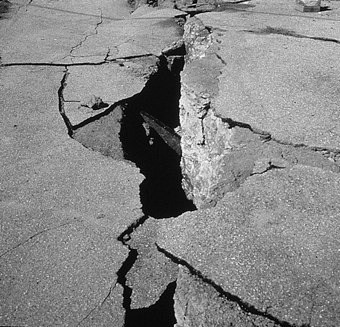My Loma Prieta story: Stuck in an elevator and tossed around like a pinball

This photo of earthquake damage on Summit Road was taken by Gary Griggs, distinguished professor of Earth and planetary sciences.
The 25th anniversary of the Loma Prieta earthquake certainly brings back memories.
I was returning to my office in Natural Sciences II and, feeling a bit lazy, I decided to take the elevator up to the third floor. That's when the magnitude-7.1 earthquake struck. I was tossed from wall to wall inside that freight elevator like a pinball. It was shocking, trying to fend off the walls I was being thrown against. Then, as suddenly as it started, it was over.
But the campus and the elevator had lost power, so I was trapped alone. I was terrified that the elevator cable would break, especially if an aftershock struck. I tried to figure out whether I would be better off standing, jumping, or lying flat on the floor if the cable broke. (Unbeknownst to me, it was a hydraulic elevator with no cable, so it was virtually immune to a catastrophic break.)
It was pretty unpleasant in that dark little box. There was no light because the campus had lost power, and in the darkness, the building's emergency alarms were blaring -- they were really loud! I felt so alone. Then the first aftershock struck, and I was tossed around again.
I did use the emergency phone to call campus dispatch. When I asked the woman who answered whether that had been an earthquake, she said, "Where have you been?" I had to explain that I was stuck in the elevator the whole time and would appreciate getting out. She told me to wait patiently because there were emergencies all over campus. Eventually, she came back on the line to ask me if I was a university employee. To this day, I suspect she was trying to determine if I had next-of-kin records on file in case the worst happened.
Finally, after about 45 minutes, the power came back on. I pressed 1, and sure enough, the elevator returned to the ground floor and the door opened! Somehow, I expected cheering crowds, but there was no one there. I propped the door open and actually went back into the elevator to tell emergency services that I was out. I soon saw one of our students, who told me that the World Series at Candlestick Park had been stopped because of the quake.
I drove down the hill to my home on Escalona Drive and told my wife that I had the best excuse she'd ever heard for being late to dinner. Like most houses in Santa Cruz, we lost our chimney in the quake, but fortunately, the house was still standing. My wife's study on the second floor, which had bookshelves on every square foot of wall space, was inaccessible because every single book had all fallen and a pile was blocking the door. I had to force the door open by a few inches and toss books to the other side of the room to clear a path and get in.
All of Santa Cruz was without power and phone service for several days. The next day, the Safeway on Mission Street opened for something like six customers at a time. I waited for hours in a line that was many blocks long. Almost everyone was there to buy water or batteries. I was on a mission to buy diapers, because we had two little ones at the time!
It turned out that Nat Sci II was severely damaged in the quake. In fact, we later learned that had the earthquake lasted a few more seconds, the building would have collapsed. It was several weeks before we were able to safely occupy the building again. They did some temporary shoring of the building, which lasted for a couple of years. Finally, we all moved to Kerr Hall so the building could be fixed. The flying buttresses they used to shore up the building are a key feature even today.
Comments or questions? Write to chancellor@ucsc.edu and put "Earthquake" in the subject line.
